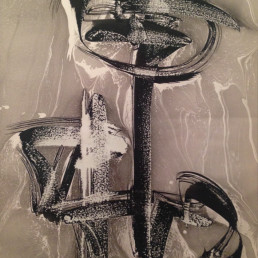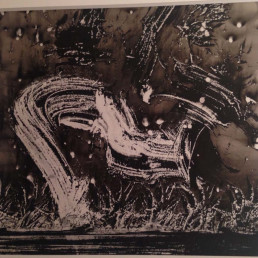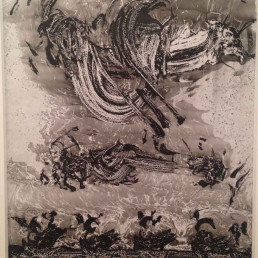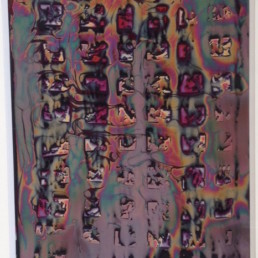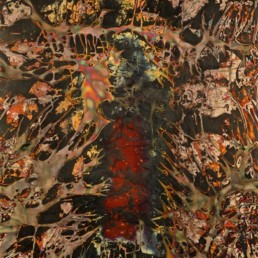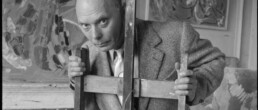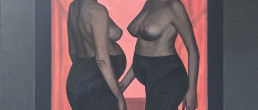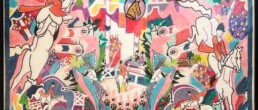Arthur Unger
1932 - 2024 (Luxembourg)
Biography
Arthur Unger was born in 1932 in the city of Hespérange, Luxembourg.
After graduting, he follows administration and management courses in Bruxelles, and then settle in Belgian Congo, where he had lived for 5 years, and specially with the tribes Lunda and Baluba. This long African journey is very important for the development of Arthur’s art.
In 1963, back to Europe, he settles in Paris. There, he discovers the artistic life of the French Capital and makes his first drawings and gouaches.
In 1968, he came back to Luxembourg, and invents a technique of drawing with Inidian Ink, and a painting technique uppon brass, using electrolytic cupper which became his favourite medium (he calls his new technique « pyrochemograms uppon cupper »).
In 1970, he meets Michel Tapié ; it is a major event in the artistic life of Arthur. Tapié is very interested in Arthur’s work and writes the forewords of all the exhibitions by Arthur Unger in France and in the world. In 1980, Michel Tapié dedicated a monograph to Arthur Unger at the Galerie Sources in Paris.
The personal exhibitions of the works of Arthur Unger mainly take place in France, in Luxembourg, in Germany and in Switzerland (three times at the Basel Art Fair).
Between 1983 and 1989, Arthur Unger makes lots of trips to visit African countries and specific tribes – such as the Dogon, Mali- and his art becomes more and more influenced by African traditional Art.
In 1987 he also make a sery of Indian Ink drawings influenced by Chinese Art called « the Samouraï ». Arthur Unger is a traveller, a curious mind interested in all the means of artistic expression that took place around the world.
In 1989, a monograph book is published by the Paris Art Center with an exhaustive study of Arthur Unger’s link with African Art by Ante Gilbota called « the African Unger ».
Arthur Unger composes a sery of big cuppers talking about Fire and Masks, which will be exhibited in 1992 at the Paris Art Center and at the Musée du Luxembourg (Paris) and then in Antibes. Then, this exhibition will take place in Luxembourg and at the Château de la Napoule (Mandelieu, France).
Arthur Unger continues to travel to Africa. His approach offers a key to interpret what we erroneously call « Primitive Art ». In his recent exhibitions, he created a dialogue between his new paintings (topic : the Dogon horsemen) and his own collection of Dogon sculptures. (Exhibitions : 1999, Espace Paragon in Luxembourg, 1999, galerie-librairie Cygne d’Etang in Paris, in decembre 1999, galerie A. Lecomte in Paris, in 2000, Espace Municipal des Congrès Europa in Mandelieu).
Arthur Unger participated to a beautiful publication of « Beauté Inversée » organized by Ante Gilboa and composed by 25 poems by the Spanich poet Fernando Arrabal, and 71 ink drawings by Arthur Unger.
Two exhibitions in 2000, in Mandelieu, and in Hespérange, aimed at presenting this beautiful Art book.
In October 2001, thanks to the writer Martin Gray, the Toit de la Grande Arche de Paris la Défense presented an important retrospective exhibition of the cupper works, totems-sculptures and several works-objects by Athur Unger, with also a lot of illustrated books.
In 2002, the Espace Paragon in Luxembourg and the Culturel Centre of the Grand-Duché de Luxembourg in Berlin dedicated two exhibitions to his work.
In 2003, a lot of personal exhibitions took place in europe : At the Galerie Martin, Marseille, France, at the Maison du Grand-Duché du Luxembourg and at the Galerie Retelet in Bruxelles, and at the Centre Barblé de Strasen in Luxembourg.
Then, in 2004, a beautiful retrospective has taken place at the Museum of Modern Art Guan Shanyue of Shenzen, and then at the Museum of Modern Art Liu Haisu of Shanghai. Another exhibition is also presentend at the Kunsthaus am Museum of Trèves (Germany).
In 2005, the Espace Paragon in Luxembourg aoffers him a new personal exhibition. The prestigious Museum of the Millenium in Beijiing organized a great personal exhibition of his work.
Personal Exhibitions :
- 1968 : Galerie Beffa (Luxembourg)
- 1972 : Galerie Municipale d’Esch sur Alzette (Luxembourg)
- 1974 : Galerie Cyrus (Paris / France) • 1976 : Galerie Geiger (Basel / Switzerland) Galerie de l’Abbaye (Echternach / Luxembourg)
- 1979 et 1980 : Galerie Sources (Paris / France)
- 1981 : Centre Culturel Français (Luxembourg) Galerie Ruchti (Cologne / Germany)
- 1984 : Galerie d’Art international (Paris / France)
- 1985 : Galerie Kutter (Luxembourg) Galerie Ludwig Lange (Berlin / Germany) Galerie du Château (Wiltz / Luxembourg)
- 1992 : Paris Art Center (Paris / France) Musée Municipal du Bastion Saint-André (Antibes / France)
- 1993 : Galerie d’Art (Luxembourg) Galerie De Zwarte Man (Bruxelles / Belgium)
- 1997 : Château de la Napoule (Mandelieu / France)
- 1998 : Galerie Gaasch (Dudelange / Luxembourg) Galerie-Librairie Cygne d’Ëtang (Paris / France) Musée d’Histoire de la ville (Luxembourg) Hôtel de Ville (Hesperange / Luxembourg)
- 2002 : Espace Paragon (Luxembourg)
- 2003 : Galerie Martin (Marseille / Paris) Galerie Retelet (Bruxelles / Belgium) Kunsthaus am Museum (Trier / Germany)
- 2006 : Galerie Cri d’Art (Amnéville les Thermes / France)
- 2007 : Kunstverein (Aalen / Germany) Atelier Anne-Marie Frères (Contern / Luxembourg) Galerie Frédéric Hessler (Luxembourg) • Galerie Crid’art (Metz / France)
- 2012 : Atelier Arraba (Valbonne – France) (with Peter Klasen)
- 2012 : Galerie F. Hessler (Luxembourg) (Indian inks)



